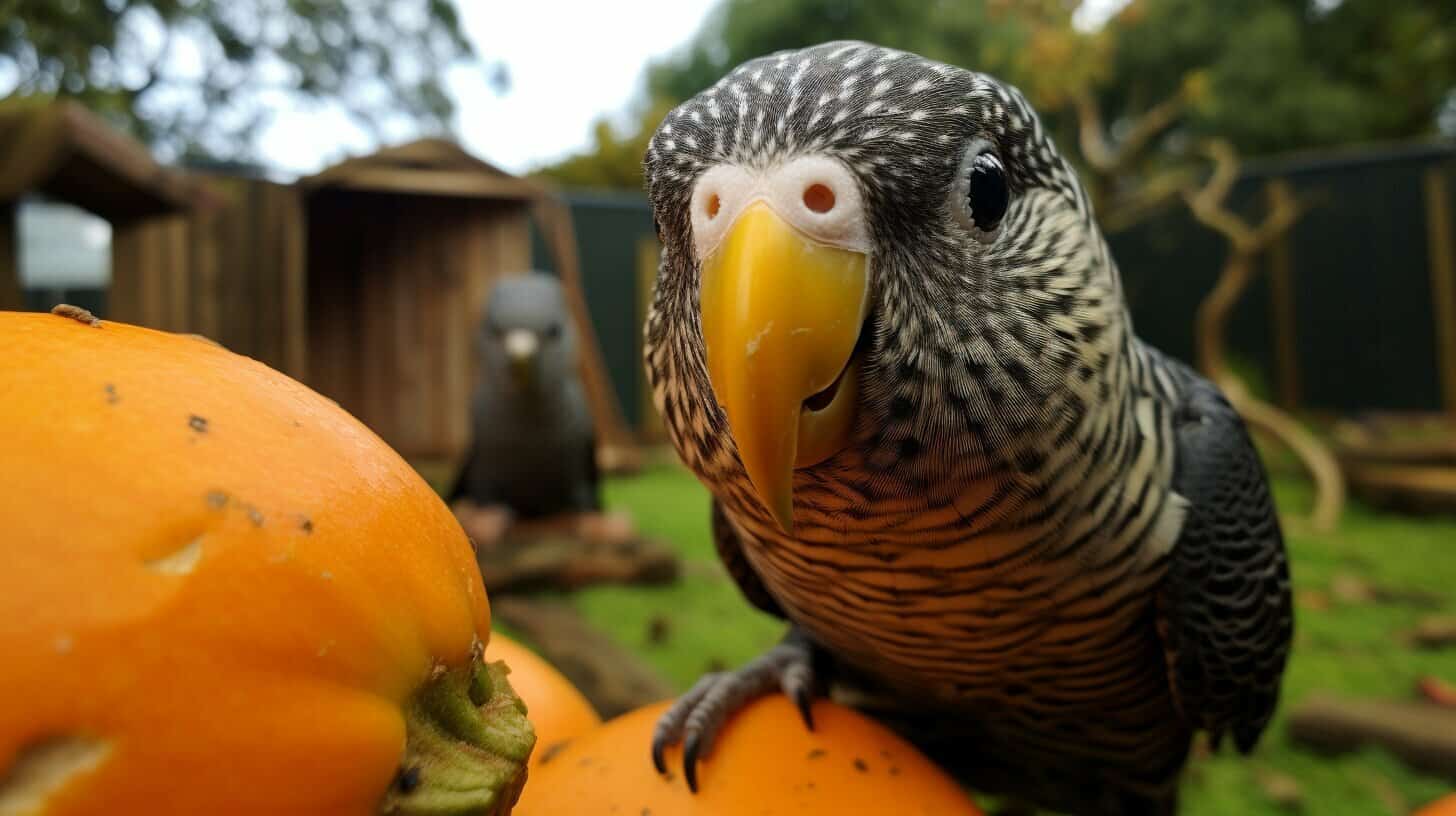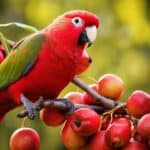If you are a kakariki owner or considering adopting one, it is essential to understand their dietary requirements for optimal health and well-being. As a responsible owner, you must provide a varied and balanced diet to meet their nutritional needs.
One question that often arises is whether kakarikis can eat pumpkin. In this article, we will explore the relationship between kakarikis and pumpkin and provide you with all the necessary information to make an informed decision.
Can Kakarikis Eat Pumpkin? Yes, kakarikis can safely consume pumpkins. Pumpkin, a nutritious vegetable, benefits a kakariki’s diet by providing vitamins, minerals, and fibre. The flesh and seeds of the pumpkin can be consumed, offering different nutrient profiles. Ensure it is fresh, raw, and well-washed to avoid chemical residues.
Key Takeaways:
- Kakarikis require a balanced and varied diet for optimal health.
- Pumpkin can be a safe and nutritious addition to a kakariki’s diet.
- Considering the nutritional benefits, potential risks, and how to introduce pumpkin to a kakariki’s diet before feeding is important.
Understanding the Kakariki Diet
As a responsible kakariki owner, it is essential to understand your bird’s dietary requirements. A balanced and varied diet is crucial for their overall health and well-being.
Kakarikis are primarily herbivores, meaning they consume mostly plant material. Their natural diet consists of various grasses, flowers, leaves, berries, and seeds. In captivity, it is essential to replicate this diet as much as possible.
| Food Groups | Examples |
|---|---|
| Fruits | Berries, apples, pears |
| Vegetables | Carrots, spinach, broccoli |
| Leafy greens | Kale, lettuce, dandelion leaves |
| Seeds and grains | Millet, quinoa, oats |
It’s also essential to note that kakarikis require a high-fibre diet to maintain their digestive health. This means that foods such as bread and pasta should be avoided as they lack the necessary fiber content.
Feeding pumpkin to your kakariki can be a healthy addition to their diet. However, ensuring that it is not the only food you are offering them is important. A varied diet will give them all the necessary nutrients to stay healthy.
Nutritional Benefits of Pumpkin for Kakarikis
Feeding your kakariki a diet that includes pumpkin can provide various nutritional benefits. Pumpkin is a rich source of vitamins, minerals and fibre that can improve their overall health.
| Nutrient | Amount per 100g of Pumpkin |
|---|---|
| Vitamin A | 246% of the daily recommended intake |
| Vitamin C | 19% of the daily recommended intake |
| Potassium | 7% of the daily recommended intake |
| Fibre | 1.5g |
Pumpkin is also low in calories, making it a great addition to your kakariki’s diet without risking weight gain. The fibre content in pumpkin can aid in digestion and help prevent constipation.
Furthermore, the vitamins and minerals found in pumpkin can support your kakariki’s immune system and overall well-being. Vitamin A, for example, is crucial for maintaining healthy vision, while vitamin C is important for wound healing and maintaining healthy skin.
Introducing pumpkin into your kakariki’s diet can have numerous health benefits, making it a great addition to their meal plan.
Pumpkin as a Safe Food for Kakarikis
If you are considering adding pumpkin to your kakariki’s diet, you may be concerned about any potential risks or dangers. Rest assured that pumpkin is a non-toxic food and is safe for your feathered friend to consume.
However, as with any new food, it is important to introduce pumpkin gradually and in moderation to avoid any digestive upset. Monitor your kakariki’s reaction to the new food and adjust the amount accordingly.
If you have concerns about your kakariki’s health or dietary requirements, consult a veterinarian or avian expert for guidance.
Introducing Pumpkin to Kakarikis’ Diet
Now that you know that kakarikis can safely eat pumpkin and the potential nutritional benefits, you may be wondering how to introduce it to their diet. Follow these tips:
- Start slowly: Introduce pumpkin gradually in small amounts to avoid upsetting their digestive system.
- Portion control: While pumpkin is beneficial, too much can lead to an upset stomach. Limit the amount to 1-2 tablespoons per day.
- Mix it up: Mix pumpkin with other foods that they already enjoy to encourage acceptance.
Here are some ways to offer pumpkin to your kakariki:
| Method | Description |
|---|---|
| Sliced Raw | Cut pumpkin into small slices and offer it raw for a crunchy treat. |
| Cooked | Cook pumpkin by boiling, steaming, or roasting and serve it mashed or diced. |
| Pumpkin Puree | Create a pumpkin puree by blending or mashing it and mixing it in with their regular food. |
By following these steps, your kakariki can enjoy the benefits of pumpkin in their diet while still maintaining a balanced and varied meal plan.
The Role of Pumpkin in Kakariki Health
As mentioned earlier, pumpkin is a nutritious food that can offer many benefits to kakarikis. Incorporating pumpkin into their diet can help support their overall health and well-being.
Pumpkin is a rich source of vitamins A and C, essential for maintaining healthy skin, feathers, and eyesight. It also contains potassium, which can help regulate blood pressure and maintain a healthy heart.
Another important nutrient found in pumpkin is fibre. Fibre helps support digestive health, preventing constipation and other digestive problems. It can also help control blood sugar levels and reduce the risk of obesity.
In addition to its nutritional benefits, pumpkin also contains antioxidants, which can help boost the immune system and protect against disease. These antioxidants can help prevent inflammation and reduce the risk of infections and illnesses.
Incorporating pumpkin into your kakariki’s diet can be an easy and effective way to support their overall health. By providing a varied and balanced diet that includes pumpkin, you can help ensure your kakariki is happy and healthy for years.
Pumpkin in a Balanced Kakariki Diet
While pumpkin can be a tasty and nutritious addition to your kakariki’s diet, it’s important to remember that it should be just one part of a balanced meal plan. Here are some suggestions for other foods you can combine with pumpkin:
| Protein | Fruits and Veggies | Grains |
|---|---|---|
| Chicken | Blueberries | Rice |
| Eggs | Broccoli | Quinoa |
| Tofu | Kale | Oats |
| Fish | Carrots | Barley |
Remember that variety is key, and monitoring your kakariki’s diet is important to ensure they are getting all the nutrients they need. By incorporating a range of protein, fruits and veggies, and grains, you can provide a well-rounded meal plan for your feathered friend.
Incorporating Pumpkin in a Kakariki’s Daily Routine
If you have decided to introduce pumpkin to your kakariki’s diet, there are a few things to keep in mind to ensure a smooth transition:
- Start with small amounts: Begin by offering a small slice or cube, about the size of your kakariki’s beak, and observe their reaction.
- Gradually increase the portion size: If your kakariki seems to enjoy the pumpkin, you can gradually increase the portion size over a few weeks.
- Combine with other foods: To encourage your kakariki to eat the pumpkin, you can mix it with other foods they typically enjoy, such as leafy greens, fruit, or seeds.
- Vary the presentation: Kakarikis are known for their curious and playful nature, so you can offer the pumpkin in different ways, such as diced, mashed, or even as a puzzle feeder.
Remember that pumpkin should not replace the staple foods in your kakariki’s diet, but rather be added as a supplement to provide variety and additional nutrients.
Potential Risks and Precautions
While feeding pumpkin to kakarikis is generally safe, there are still a few potential risks and precautions to remember.
Firstly, pumpkin should not be a substitute for a varied and balanced diet. While it can provide excellent nutritional benefits, relying solely on pumpkin can lead to deficiencies in other essential nutrients.
Additionally, it’s essential to monitor your kakariki’s response to pumpkin. All birds are unique; some may experience digestive upset or other adverse reactions. Start with small portions and gradually increase the amount over time to gauge your bird’s tolerance.
If you notice any signs of illness, vomiting, or diarrhoea after introducing pumpkin, remove it from their diet and consult with a veterinarian.
Finally, be cautious when introducing pumpkin seeds, as they can be a choking hazard for birds. Remove them from the pumpkin before serving, or purchase pre-shelled seeds to avoid potential risks.
Conclusion
Congratulations! You now know that kakarikis can eat pumpkin and how to introduce it into their diet safely. Remember, a balanced and varied diet is crucial for their health, and including pumpkin can offer numerous nutritional benefits.
Monitor their intake and gradually introduce pumpkin, as with any new food, to avoid potential adverse reactions. You can easily incorporate pumpkin into your kakariki’s daily routine with a little patience and moderation.
Happy feeding!
FAQ
Q: Can kakarikis eat pumpkin?
A: Yes, kakarikis can eat pumpkin.
Q: What is the kakariki diet?
A: The kakariki diet includes a variety of fruits, vegetables, seeds, and pellets to ensure a balanced and nutritious intake.
Q: What are the nutritional benefits of pumpkin for kakarikis?
A: Pumpkin is rich in vitamins, minerals, and fibre, which contribute to the overall health of kakarikis.
Q: Is pumpkin a safe food for kakarikis?
A: Pumpkin is a non-toxic food that can be safely included in a kakariki’s diet.
Q: How can I introduce pumpkin to my kakariki’s diet?
A: It’s best to introduce pumpkin gradually by adding small amounts to their regular food. Monitor their acceptance and adjust accordingly.
Q: What is the role of pumpkin in kakariki health?
A: Pumpkin can contribute to improved digestion, immunity, and overall well-being of kakarikis.
Q: What other foods should be included in a balanced kakariki diet along with pumpkin?
A: Along with pumpkin, kakarikis should also be fed a variety of fresh fruits, vegetables, seeds, and pellets to ensure a well-rounded meal plan.
Q: How can I incorporate pumpkin into my kakariki’s daily routine?
A: Pumpkin can be served cooked, mashed, or as a puree. It can be mixed with other foods or presented as a treat.
Q: Are there any risks or precautions when feeding pumpkin to kakarikis?
A: While pumpkin is generally safe, feeding it in moderation is important and monitoring for any adverse reactions is important.
Q: Can I feed my kakariki pumpkin seeds?
A: Yes, it is safe to feed your kakariki pumpkin seeds in moderation. However, ensure they are plain, unsalted seeds without adding seasonings or flavours.
Q: How much pumpkin should I feed my kakariki?
A: It is recommended to start with a small amount, such as a teaspoon or two, and gradually increase the amount if your kakariki tolerates it well. As a rough guide, 5-10% of their daily food intake can be made up of vegetables, including pumpkin.
Q: Can feeding pumpkin to my kakariki cause digestive issues?
A: While pumpkin can benefit digestion, feeding too much or introducing it too quickly can cause digestive issues such as diarrhoea. Make sure to introduce pumpkin gradually and monitor your kakariki’s stool for any changes.
Q: What other vegetables can I feed my kakariki alongside pumpkin?
Kakarikis require a varied and balanced diet, so including a range of vegetables and pumpkin is beneficial. Examples include leafy greens like spinach and kale, sweet potato, carrots, and broccoli.
Q: Can pumpkin be given to kakarikis as a treat?
Yes, pumpkin can be given as an occasional treat in small amounts. However, do not replace their regular diet with pumpkin or other treats.



Have comments or questions about this article? Then get involved!
Spotted an error or something we have missed? Let us know